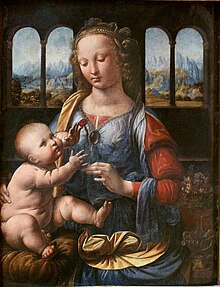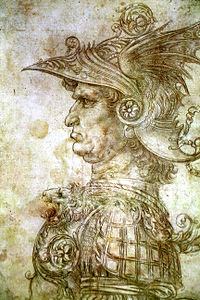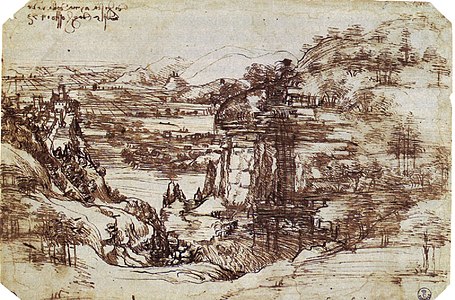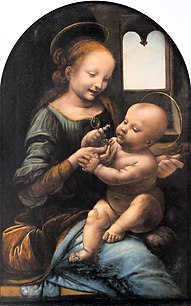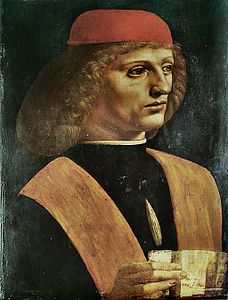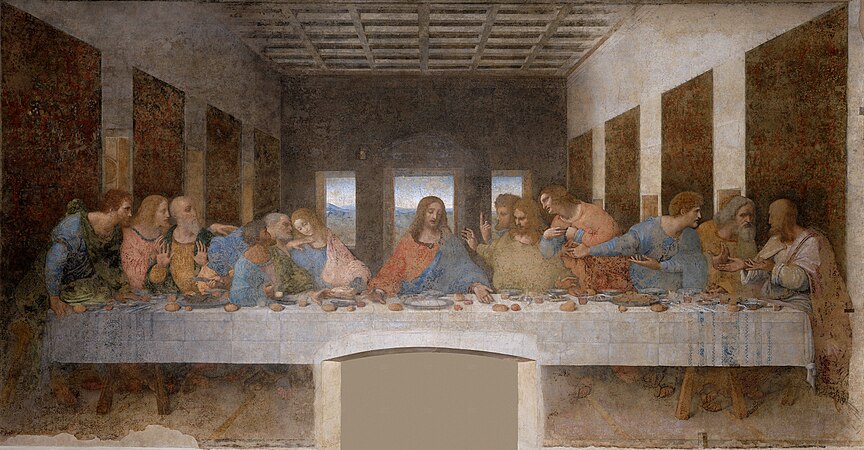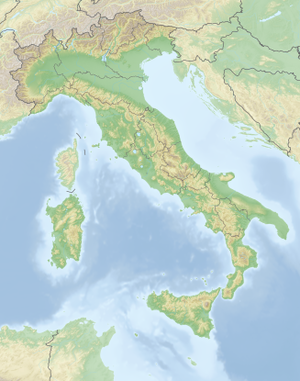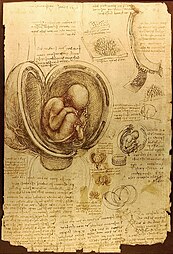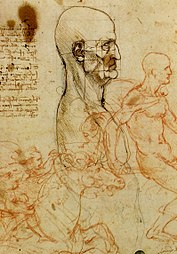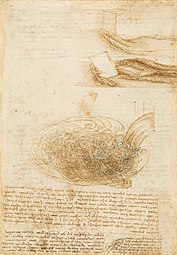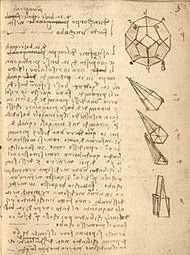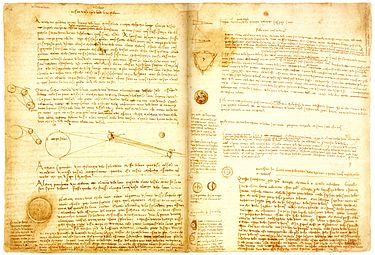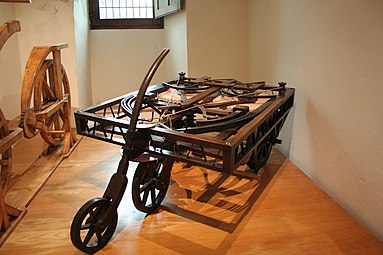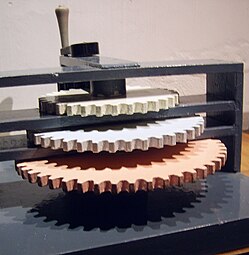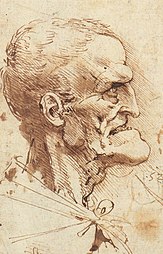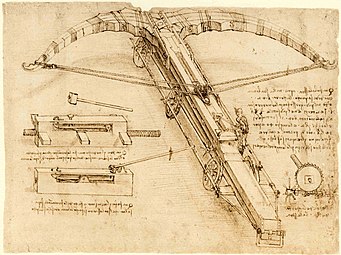Leonardo da Vinci

Leonardo da Vinci [ ˌleoˈnardo da ˈvːintʃi ] (* April 15, 1452 in Anchiano near Vinci ; † May 2, 1519 at Clos Lucé Castle , Amboise ; actually Lionardo di ser Piero da Vinci [son of (Mes) ser Piero from Vinci]) was an Italian painter , sculptor , architect , anatomist , mechanic , engineer and natural philosopher . He is considered one of the most famous polymaths of all time.
His name addition da Vinci is not a family name , but a name of origin and means "from Vinci", but this designation of origin was taken as part of his name and used by Leonardo da Vinci himself in his signatures. The birthplace Vinci is a fort or fortified hill village and is located near the city of Empoli (about 30 kilometers west of Florence ) in what is now the province of Florence , Tuscany region .
Origin, teaching and studies (1452–1481)
origin
Leonardo's parents were the 25-year-old notary Piero da Vinci (1427–1504) and the then 22-year-old maid Caterina. In the meantime, one suspects a baptized Arab slave who worked temporarily as a maid for Piero. However, the hypothesis is controversial and controversial.
The mother later married the pottery owner Accattabriga di Piero del Vacca from Vinci and had five more children. The father Piero was married four times and had nine sons and two daughters by his last two wives. He adopted Leonardo as his biological son. As a successful notary, the de 'Medici family were among his clients as well as members of the ruling Signoria , the council of the city-state of Florence .

Leonardo, who lived with his father's family from 1457, spent most of his youth in Florence. He was interested in music, drawing and modeling from an early age. Through the mediation of his father, with whom Leonardo had moved to Florence, the artist Andrea del Verrocchio (1435–1488), who recognized the boy's artistic talent , took him into his workshop in 1469 .
Apprenticeship with Verrocchio
Verrocchio was one of the most important sculptors in Florence at the time, who also worked as a painter and goldsmith. Leonardo learned and worked in his studio from around 1470 to 1477, in the company of other students such as Perugino (around 1445 / 1448–1523), Domenico Ghirlandaio (1449–1494) and Lorenzo di Credi (around 1459–1537).

In the artist workshops of the 15th and 16th centuries, it was common for the master not to carry out the creation of a work alone, but to entrust parts of the execution to his journeymen and students. Probably the earliest surviving evidence of a painting from Verrocchio's workshop with Leonardo da Vinci's participation is Tobias and the Angel (dated around 1470–1475). Art historians assume that Leonardo could have painted the fish in Tobias 'left hand, the dog at the angel's feet and also Tobias' head of hair. These pictorial objects, so claims the Leonardo biographer Charles Nicholl , showed a virtuosity and perfection that Verrocchio was unable to achieve .
After completing his apprenticeship, at the age of around 20, Leonardo continued to work in Verrocchio's workshop. According to the painter, architect and artist biographer Giorgio Vasari (1511–1574), Leonardo painted the angel kneeling on the left in the painting The Baptism of Christ . Verrocchio made the painting for the monks of Vallombrosa . Today it is in the collection of the Uffizi Gallery in Florence. The picture, which was originally painted in tempera , was later partially overpainted in oil (possibly by Leonardo), so that it is difficult to make an informed judgment about the copyright. Leonardo's contribution is suspected not only in the angel's face, but also in parts of the clothing and the landscape background. Leonardo's sfumato technique, his characteristic soft focus on motifs, can already be seen in the left part of the landscape background . The picture is dated to around 1475, when the picture Annunciation to Maria and Leonardo's studies for drapery of robes and the profile of a warrior were also made.
Leonardo's name has been on the lists of the Saint Luke Guild ( Compagnia di San Luca ), the painters' guild of Florence, since 1472 . He lived and worked in Florence for another ten years, working with the painters Sandro Botticelli and Perugino, among others . In contrast to Michelangelo (1475–1564), who was born later , Leonardo was portrayed as open and friendly.
Leonardo faced a sodomy charge in 1476 . In the Middle Ages and early modern times , this term also stood for homosexuality . Leonardo was accused of having had sexual contact with the 17-year-old prostitute Jacopo Saltarelli . Officials of the Florentine Magistrate investigated him, but the allegation could not be confirmed and Leonardo was acquitted.
He started early to write down his thoughts and feelings in notebooks ( codici ). From his notes it can be concluded that he did not, like other Renaissance artists, want to revive the splendor of ancient art by imitating models, but felt himself called as a student of nature to depict the beauties of nature itself and these in interaction with people. Strange shapes of hills and rocks, rare plants and animals, movements of water, unusual faces and figures of people were the things that he took up in his paintings and in his studies of nature. The earliest dated drawing is the Arno landscape from August 5, 1473 (now in the Uffizi). He usually painted his portraits against a background landscape and recorded a variety of plant and animal studies in his notebooks.
Around 1477 he seems to have found favor with Lorenzo il Magnifico (1449–1492), lord of the city of Florence, and worked as a freelance artist under his patronage . The first portraits and images of the Virgin were created , the Benois Madonna (1475–1478, Hermitage , Saint Petersburg) and a portrait of Ginevra de 'Bencis (1478–1480, National Gallery , Washington DC), a daughter of Amerigo de' Benci, Leonardo's passion shared for cosmographic studies. In 1481 he received his first major commission from the Augustinian monastery of San Donato a Scopeto near Florence for an altarpiece and he drew the sketches for the Adoration of the Magi (now in the Uffizi). When many of his artist friends settled in Rome to work for the Holy See , in 1481 the opportunity arose for him to work at the court of the Sforza , the dukes of Milan .
- Early works
Early Milanese Years (1482-1499)

The Sforza family ruled Milan and Lombardy from 1450 to 1535. The founder of the dynasty , which was mostly closely allied with the Florentine ruling Medici family , was Francesco Sforza (1401–1466). After his death, his eldest son Galeazzo (1444–1476) became a duke. After his assassination in 1476, Ludovico Sforza (called il Moro , "the dark one"; 1452–1508) came to power as the protector of his nephew Gian Galeazzo Sforza (1469–1494), but actually as a usurper of the state. Ludovico took up a project to erect an equestrian monument by Francesco Sforza in honor of the founder of the ruling house and looked for a suitable artist. The Medici recommended the young Leonardo, who then presented himself to the court in Milan.
Because of the impending fighting between Milan and the Republic of Venice , Leonardo mentioned in a letter of recommendation to the Duke in detail his skills and inventions in military technology . Only at the end of the letter did he emphasize his skills as a civil engineer and architect and finally added a brief reference to his knowledge as a painter and sculptor, which could form the basis for an appropriate execution of the monument for Francesco Sforza. After his employment, Leonardo worked intermittently for the Sforza for over twenty years.
In Milan, Leonardo developed into the leading artist and the organizer of court ceremonies and festivities. On the occasion of the wedding of the young Duke Gian Galeazzo to Isabella of Aragon in 1487, the artist designed the sets and costumes for the Masque Il paradiso . The plague epidemic in Milan from 1484 to 1485 prompted him to submit plans to the prince according to which the city should be subdivided and rebuilt according to improved sanitary principles. In his notebook he noted:
“The middle, underground main channel does not take in cloudy water, but water that flows through the ditches outside the city, with four mills at the entrance and four at the exit. This is done by damming the water above Romoloutino. "
Leonardo, who, in contrast to many of his contemporaries, was extremely well-groomed and paid great attention to cleanliness (and already recognized the connection between plague and dirt), organized the first garbage collection in Milan with the help of boats and thus contributed to a significant improvement in the quality of life in town. In the years 1485–1486 he was involved in the planning of the beautification and reinforcement of the Castello and the completion of the Milan Cathedral . However, he could not assert himself and thereupon designed a bathing pavilion of unusual sophistication and beauty for the young Duchess.

At the same time he made notes of the results of his studies in geometry, statics and dynamics, human anatomy and the phenomena of light and shadow and studied the design of the Sforza equestrian monument in detail. He conducted intensive studies on the movement and anatomy of horses and on the art and science of bronze working and casting technology. The equestrian statue was to become the largest bronze statue of that time.
After seven years, in 1490 at the insistence of his client, he prepared his equestrian statue model - initially made of clay - on the occasion of Ludovico's marriage to Beatrice d'Este for demonstration. At the last moment, however, he was not satisfied with his work and started all over again.
In the same year, Leonardo spent a few months undisturbed doing mathematical and physical research in the libraries and among the scholars of Pavia . He had been appointed as a consultant on some of the architectural difficulties in the construction of the cathedral. In Pavia he received new ideas for his Francesco Sforza by studying an ancient equestrian monument (the so-called Regisole , which was destroyed in 1796). The study on body proportions according to Vitruvius as well as proportion studies on human bodies and faces and anatomical studies come from the year 1492 , because he wanted to get to know “the inside of man” and began to work on his book From the human figure .
In the years that followed, the increasing festivities and pageantry of the Milanese court brought him continual commissions, including the composition and recitation of sagas, fables, and prophecies (i.e., moral and social satires and allegories formulated in the future tense ).
Images of the Milan era
The first version of the Madonna in the rock grotto ( rock grotto Madonna ) was created between 1483 and 1486 . He received the commission from the Brotherhood of the Immaculate Conception in the Franciscan Church of San Francesco in Milan. This version was never handed over because the scene is depicted in a cold, lifeless cave, contrary to the wishes of the brotherhood, and Jesus and John the Baptist are shown without gold and halos. In 1499 the painting came to France. Today it is in the collection of the Louvre in Paris. A second version, accepted by the brotherhood, was painted between 1493 and 1508, begun by Leonardo and continued by his pupil Ambrogio de Predis (around 1455 – after 1508). It is now in the National Gallery in London .
In the 1480s, Leonardo dealt intensively with military engineering tasks. The notebooks of this time show sketches of weapons, war machines, flying machines and ships. Around 1490 Leonardo designed the Madonna picture of the Madonna Litta , the execution is today attributed to his pupil Giovanni Antonio Boltraffio (1467–1516), as well as the portrait of Cecilia Gallerani , a mistress of Ludovico Sforzas ( The Lady with the Ermine , today in the Czartoryski Museum in Krakow ). The portrait of a young man (portrait of the musician Franchino Gaffurio ) and the portrait of an unknown lady belong to the same period . However, neither of the images is unequivocally attributed to Leonardo.
- Painting of the first Milanese era
Il Cenacolo ( The Last Supper )
When Leonardo was around 40 years old and had worked for the Milanese court for almost ten years, Ludovico Sforza commissioned him to paint a picture for the front wall of the refectory of the convent of Santa Maria delle Grazie in Milan.
The picture The Last Supper (Italian: Cenacolo or Ultima Cena ), a mural with dimensions of 8.8 × 4.6 m, was admired by many artists while it was being made . It was created between 1494 and 1498. It depicts the moment , in which Jesus informs his disciples that one of them would betray him in a few hours.
Leonardo painted the picture in tempera on a dried plaster wall ( Secco painting ), neither as a fresco nor in oil , as later legends have claimed. The tempera carrier did not last long on the plaster of paris, nor did it on the wall. Dampness and mold caused peeling and flaking. This process dragged on over several decades. The attempts at restoration in the 18th century were based on the false assumption that the work was carried out in oil. So it was once painted over with oil in the hope of being able to restore the colors. Others tried different "secret agents", mostly harmful paints and adhesives . It was not until the mid-1970s that modern restoration techniques could stop further deterioration. Another restoration followed around the turn of the millennium. The condition of the factory has now been documented with a resolution of 16 gigapixels.
In spite of the great damage, the half-resolved picture always left a deep impression on the most diverse viewers. In May 1788, Goethe also saw the picture on his return trip from Rome . Later he wrote an essay on Leonardo's Last Supper, which states, among other things:
“... by which Leonardo mainly enlivened this picture: it is the movement of the hands; but only an Italian could find this. With his nation, the whole body is witty, all limbs participate in every expression of feeling, passion, even thought ... "
In order to be able to portray the people as characters, Leonardo carefully selected his “types” and made many facial studies. The faces of Jesus and Judas remained unfinished, the perfectionist Leonardo could not find a satisfactory solution for a pictorial representation.
Friendship with Luca Pacioli
After the success of his Last Supper , Leonardo continued work on the Sforza monument - the Cavallo - the seven-meter-high clay model of which had been in the Corte Vecchio des Castello for three years and was widely admired. Now the monument should be cast in bronze. Leonardo got help with the difficult calculations for the bronze casting from the mathematician Luca Pacioli from Borgo San Sepolcro, whose Summa de aritmetica, geometrica etc. Leonardo had acquired when it first appeared in Pavia. The mathematician admired Leonardo's paintings and sculptures and even more his mathematical, physical and anatomical research, which he got to know in Leonardo's manuscript collections. Both worked on Pacioli's next book De divina proportione ("About the divine relationship"), which dealt with the golden ratio . They also tried to solve the mathematical problem of squaring the circle , which has existed since antiquity .

Soon Pacioli also took part in the completion of the interior decoration of certain chambers of the Castello, the Saletta Negra and the Sala delle Asse , which had already been started by other artists. During repair work at the end of the 19th century, Paul Müller-Walde exposed traces of Leonardo's craft under the newly plastered and whitewashed ceilings; Many traces of Leonardo's were found in the large Sala delle Asse. Much of the decoration was well preserved and could therefore be restored.
For this and other artistic work Leonardo was rewarded with a garden outside the Porta Vercelli in 1498, at a time when money was scarce and his salary was long behind. But again, he couldn't finish the task, just like the bronze monument that the Duke finally had abandoned for lack of bronze (which he needed for weapons). But this did not help him, his expulsion in 1499 by the French King Louis XII. to prevent. Ludovico had to flee, Leonardo and other artists left Milan.
Wandering years (1499-1512)
Back in Florence
When Leonardo and his friend Luca Pacioli left Milan in December 1499, their destination was Venice . Leonardo offered his services as an engineer there and presented his war machines, including a diving suit for underwater combat. However, he did not get a job and moved on to Mantua , where he was received by the Duchess Isabella Gonzaga , who was considered the most cultivated lady of her time. He promised to paint a portrait of her at a later date; first he made a chalk drawing that is now in the Louvre.

In April 1500 , the friends moved to Florence , which had just survived Savonarola's reign of terror and had become a republic again. Here Leonardo found temporary refuge in the Annunziata monastery, where he undertook to paint an altarpiece for the Basilica della Santissima Annunziata. A year passed without the assignment being carried out. Scientific questions of physical geography and engineering attracted Leonardo more than painting. He wrote to correspondents to inquire about the tides in the Euxinian and Caspian Seas. To inform the Mercanti , he reported on the measures to be taken against an impending landslide on the hill of San Salvatore dell'Osservanza. He presented drawings and models for the canalization and control of the Arno and developed a plan to transport the Florentine Baptistery (Dantes bel San Giovanni ) to another part of the city, where it was to be placed on a large marble plinth.
Finally, in April 1501, he presented the impatient Servite brothers of Annunziata with a draft of the altarpiece on cardboard, which was exhibited in Florence with a large audience. The theme was the Virgin who, sitting on Saint Anne's lap, leans over to hold her child, who has half escaped from her embrace, to play with a lamb on the floor. Despite the general praise for his design, Leonardo did not complete the altarpiece. The monks of Annunziata had to give the order to Filippino Lippi , after whose death the task of Perugino was ended. Leonardo only completed the painting later (1506–1516), which can be seen today in the Louvre as Anna Metterca or Anna selbdritt ("Anna zu threes").
In Florence, Leonardo tried to get orders. The gonfaloniere Piero Soderini offered him a huge block of marble to freely use, but Leonardo declined with thanks. Three years later, Michelangelo knocked his David out of this block. The French court commissioned him to make another picture of the Madonna; In 1501 he painted the Madonna with the spindle . But actually he was much more interested in technical and scientific challenges and was looking for a princely client.
In the service of Cesare Borgia
In the spring of 1502 he entered the service of Cesare Borgias , Duke of Valentino. At the time , he was busy consolidating his recent conquests in Romagna . Between May 1502 and March 1503, Leonardo toured a large part of central Italy as the chief engineer. After a visit to Piombino on the coast across from Elba , he drove via Siena to Urbino , where he made cartographic drawings. Then he was called to Cesena via Pesaro and Rimini ; between Cesena and Cesenatico he spent two months planning and managing canal and harbor works and was commissioned by Frederick II to plan the restoration of the palace .
Then he accompanied his employer, who was besieged by enemies in Imola . It was here that Leonardo met Niccolò Machiavelli , who, as envoy from Florence, was negotiating with Cesare. He followed him to Sinigallia , Perugia and finally via Chiusi and Acquapendente to Orvieto and Rome , where Cesare arrived in February 1503. During this time, Leonardo left the unscrupulous duke and returned to Florence.
Painting of the battle of Anghiari
In 1503 Leonardo was commissioned to create a large battle painting for one of the walls of the new council chamber in the Palazzo della Signoria . His theme was an episode of the victory of the Florentines over the Milanese near a bridge near Anghiari in the upper Tiber valley . Michelangelo , who had just finished his David , was entrusted with another battle painting on the opposite wall of the room. His subject was the battle of Cascina .
To prepare the box, Leonardo was assigned the Sala del Papa in Santa Maria Novella . His continuous work on the box becomes clear from his reports to the Signoria and from receipts for his fee, wages and material bills. In less than two years (1504–1505) the box, which has not been preserved, was finished. When this was exhibited together with that of Michelangelo, both designs were admired as great works of art and served the students of the time as models and examples, just as the frescoes by Masaccio in Santa Maria del Carmine had helped the students two generations earlier. The young Raphael also learned from Leonardo during this time, as did Fra Bartolommeo .
Leonardo transferred his design onto the surface of the wall. To do this, he experimented with a new technical method which, after a preliminary experiment in the Sala del Papa, he believed was promising. The colors had to be applied to a specially prepared substrate, whereupon those - colors and substrate - were connected by means of heat. Heat from fire bowls was used to accelerate the drying process, but it was uneven: the colors ran or peeled off the wall. In 1506 Leonardo, who was on leave for an assignment in Milan, broke off the work and did not resume it when he returned to Florence. The engineer and measurement technician Maurizio Seracini suspects that the painting is still there behind a wall on which there is now a fresco by Vasari. His drilling through the Vasari fresco, which has not yet led to any results, was stopped in September 2012.
Mona Lisa
In the years 1503–1506, Leonardo also worked intensively on the portrait of the Mona Lisa . Some sources show that the Neapolitan housewife Monna Lisa del Giocondo (née Gherardini) , wife of Francesco di Bartolommeo di Zanobi del Giocondo , was the model for this picture. In Lisa Gherardini he is said to have found a model whose face and smile possessed a unique, enigmatic charm. He worked on this portrait for part of four consecutive years and had music played during the sessions. During his life, Leonardo could not part with the picture (dimensions 77 × 53 cm). Recent research indicates that the client was Giuliano di Lorenzo de 'Medici and that the picture depicts an idealized mother. Other sources are said to prove that Mona Lisa is the secret lover Salaj , who was the model for the picture. Accordingly, the painting is actually a representation of a man. The name Mona Lisa is an anagram to Mon Salai (German: "My Salai"). Leonardo's first biographer, Giorgio Vasari (1511–1574), mentioned this thesis on anagram.
After his death the work remained in the estate, was administered with other paintings by his pupil Salaj and was later acquired by Francis I of France for four thousand gold florins. It has been on display in the Louvre since 1804 . It temporarily came into the possession of Napoleon , who placed it in his bedroom and was fascinated by the enigmatic smile.
Today the painting is a real crowd puller, but after an attack in 1956, the original can only be viewed through bulletproof glass. The richness of colors has evaporated over the centuries, partly due to damage, partly because in his efforts to create effects the painter was used to modeling his figures on a background that became darker over time. But even when it is darkened, the sophistication of the expression and the precision and delicacy of the drawing remain recognizable.
In the service of the French court
On July 9th 1504 Leonardo's father died in Florence and in 1506 his uncle Francesco, who made his nephew the sole heir. There were legal disputes with his half-siblings. There was also a dispute with the Signoria in Florence, presumably over an unfinished mural ( The Battle of Anghiari ) in the hall of the five hundred of the Palazzo Vecchio. Leonardo accepted an offer from the French court and became court painter and chief engineer in Milan. There Ludwig XII. Charles d'Amboise , Marshal of Chaumont, lieutenant of the French king in Lombardy , was appointed viceroy. Both of them admired Leonardo very much ("our dear and much-loved Leonardo"), particularly appreciated his organizational talent when it came to organizing royal festivities, and on the other hand gave him a free hand, especially for his scientific research and anatomical studies, which he carried out together with the then famous anatomy professor of Pavia, Marcantonio della Torre (1481–1511).
He was also challenged as an engineer, on the one hand with planning for a new palace near Porta Venezia , on the other hand with large hydraulic projects and irrigation works (dams, canals) in Lombardy. He constructed the first water meter and dealt intensively with “the knowledge of water” in a study.
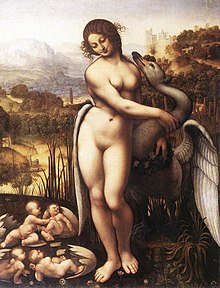
With the support of Charles d'Amboise, Leonardo was also able to settle the old dispute over his altarpiece Madonna in the Rock (which was now in the possession of the King of France). He made a copy (with the help of Ambrogio da Predi). Around the same time he continued to work on his pictures Anna Metterca and Mona Lisa . He painted Leda with the swan (the original painting is thought to be lost) and the first drafts for John the Baptist . His new friend, student, but also Amanuensis became Francesco Melzi . In the villa of the Melzi family in Vaprio, where Leonardo frequented regularly, a Madonna on one of the walls was traditionally attributed to him, or at least it was painted under his guidance.
Leonardo received an interesting assignment from Gian Giacomo Trivulzio, who had conquered Milan as a French commander and wanted a dignified burial place after his death. Based on the old work of the Sforza equestrian statue, Leonardo designed the Trivulzio Monument (rearing horse with rider). But even this project could not be realized in the end, just like his plans to compile the knowledge of the time (with the help of his now numerous notebooks) as an encyclopedia .
When his patron Charles d'Amboise died in 1511 and the political situation in northern Italy changed again (the Medici and Sforza came to power again in 1512), the now sixty-year-old left the city of Milan and moved to his student Francesco Melzi in the palazzo Trezzo of the Melzi family to Vaprio d'Adda . It is believed that he painted the red chalk drawing with the head of a bearded man there , the so-called " self-portrait of Leonardo da Vinci ". Today the drawing is in the collection of the Biblioteca Reale in Turin .
The last years (1512-1519)
Rome, in the service of the Vatican
In the meantime, Pope Julius II had made Rome the center of Italian art. When Giovanni de Medici succeeded him as Leo X in 1513 , Leonardo was called to Rome as an artist by the Pope's younger brother, Giuliano di Lorenzo de 'Medici . He was housed in the Belvedere of the Vatican and saw many old friends like the builder Donato Bramante or the painter Sodoma . He got his own studio with a German colleague who, however, had the task of keeping the Pope, who had no sympathy for Leonardo, always informed about his activities.

The conditions in Rome turned out to be unfavorable for Leonardo. He was only half-heartedly tolerated by the Pope, quite differently the younger artists Raffael and Michelangelo , who gained great recognition for their work in the rooms and the Sistine Chapel and were supported by the Pope. Her rival supporters hated each other and bitterly turned against the veteran, now graying favorite of the Medici. The young Raphael, however, admired his old role model and had immortalized him years earlier in his large fresco The School of Athens as the central Plato .
In his Roman years, Leonardo suffered not only from diseases, but also from the hectic pace and intrigues in the Vatican. For the first time in his life he felt neglected and insulted, especially when he was spied on for his anatomical studies and accused of being corpse-fiddled and impious. Overall, Leonardo stayed in Rome for almost two years and hardly worked as a painter (apart from the smiling John the Baptist), but more as an engineer. Among other things, he worked on a project to generate energy from sunlight. With the help of a German mirror maker and a metal smith, he built various concave mirrors (sun reflectors) in order to convert solar energy into heat and to obtain boiling water for a dye works.

The only engineering activities known from Leonardo's time in Rome were work on the port and defenses of Civitavecchia and activities to drain the Pontine Marshes . Through further extensive anatomical studies, Leonardo discovered arteriosclerosis in old people. But his notes on this were never published and remained lost for centuries, as did his apocalyptic visions, which were later found in the Codex Atlanticus.
Meanwhile, his French patron Louis XII. died in the last days of 1514. His young and brilliant successor, Francis I of France, surprised Europe: he advanced across the Alps at the head of an army to assert his rights in Italy and to retake the Duchy of Milan at the Battle of Marignano . After some hesitation, in the summer of 1515, Leo X ordered Giuliano de Medici to lead the papal troops into Emilia and watch the invaders move. Leonardo accompanied his patron to Florence, where Giuliano fell ill and died on March 17, 1516. In his old hometown, Leonardo was introduced to the new French king. The young sovereign and the old artist and scientist got on well, and so the old master accepted - after initial hesitation - the invitation of the king to spend his final years in France, where he was assured a new home, honor and respect. Again he packed all his belongings (especially three of his pictures: Mona Lisa , Johannes and Anna selbdritt ) and set off on the long journey with his students Salai and Francesco Melzi.
Retirement home in France
Leonardo da Vinci spent the last two years of his life in the Clos Lucé Castle in Amboise , which was left to him along with a generous pension. The court came to Amboise often, and the king regularly enjoyed the company of his protégé. He stated that Vinci's knowledge of philosophy and the fine arts was beyond what all mortals would know.
In the spring of 1518, Leonardo had the opportunity to use his old talents as a party organizer when the Dauphin was baptized and a Medici-Bourbon wedding was celebrated at the same time . In Rome he had already constructed a mechanical lion that, to the amazement of all the guests, could move a few steps on its own. Among the guests was Cardinal Louis d'Aragon , whose secretary left a report stating that Leonardo appeared to suffer from a disability that affected the movement of his right hand. He showed the cardinal three of his pictures: Mona Lisa , Anna selbdritt and a youthful John the Baptist . He may have completed this probably last picture of his hand in France. It shows the darkened image of John prophetically pointing up with one finger. Leonardo's chiaroscuro technique is particularly clear here .
Until a few weeks before his death, Leonardo was active, be it as a planner for a new palace in Amboise, as a project engineer for a large canal ( Canal du Center ) between Loire and Saône or as a draftsman of anatomical studies or architectural studies in his books. Towards the end of his life, the wise Uomo universale foresaw the end of mankind - whom he little respected - and painted various water studies of the Flood that were found in his notebooks. It also read:
“The air will be thinner and without moisture, the rivers will remain without water, and the soil will no longer allow any growth. The animals will starve to death. There will be nothing left for people either but to die. The once fertile earth becomes desolate and empty. "
Death and inheritance

On Easter Eve 1519, near death, Leonardo made his will. He determined that masses should be read and candles lit in three different churches in Amboise. He wanted to be buried in the cemetery of what was then the monastery church of Notre-Dame-Saint-Florentin in the Amboise castle grounds with a ceremony in which sixty poor men were to take part as torchbearers.
Vasari tells of a conversion and repentance of Leonardos on his deathbed in the Castle of Clos Lucéin (Amboise) . Although many of his masterpieces show Christian motifs (they were mostly commissioned works), no statement can be made about his attitude towards the church and religion. He was often suspected by the church of practicing magical arts . However, Leonardo was a scientist and, unlike many of his contemporaries, rejected magical practices. Experience was the basis of his work . Research into the laws of nature interested him more than religious dogmas; but when he mentioned these, he did so with respect. After receiving the final sacraments of the church, he died on May 2, 1519. King Francis is said to have wept over the loss of Leonardo in Saint-Germain-en-Laye , other sources report that Leonardo died in the king's arms.
After a preliminary burial in a location unknown today, da Vinci's bones were buried on August 12, 1519, in accordance with his last will, in the cemetery of the former Notre-Dame-Saint-Florentin monastery in the Amboise castle grounds. In 1807, Roger Ducos , a consulate friend of Napoleon's , had the Romanesque monastery church torn down because it "blocked his view" . The bones of Leonardo da Vinci have since been considered lost. During excavations from June 1863 on the area of the former monastery church, bones that were believed to be the mortal remains of Leonardo da Vinci were found, and in 1874 they were relocated in a new grave in the south-eastern transverse arm of the Hubertus chapel, which is also located in the Amboise castle grounds. Regardless of the grave there, knowledge of the actual whereabouts of Leonardo's corpse is still uncertain.
Da Vinci left all his manuscripts and all the equipment in his studio together with other gifts to his executor Francesco Melzi , his servant Battista Villani and Salai half of his vineyard outside Milan, money and clothes to his maid Maturina, and more money to the poor in the hospital Amboise and four hundred ducats deposited in Florence, his half-brothers.
Work and appreciation
The main places of activity of Leonardo da Vinci. Leonardo only spent the last two years of his life outside of what is now Italy, at Clos Lucé Castle near Amboise, France. |
Sigmund Freud writes in his little book A Childhood Memory of Leonardo da Vinci (1910):
"He was like a person who had awakened too early in the darkness while the others were still asleep."
Leonardo saw himself primarily as a moral and natural philosopher and used both writing (prose and poetry) and images (paintings and sketches) to express his intentions. He noted:
"Poetry has to do with moral philosophy , painting with natural philosophy ."
Significance for art and science
Leonardo created not only numerous works of art, but also a large number of designs for buildings, machines, objets d'art, paintings and sculptures, which he never found the time to realize. He said of himself that he loved the idea more than its execution, and that at the beginning of an activity he was already thinking about the end. Doing and recognizing were equally important to him. His energy was partially paralyzed by his great urge to research. First of all, he wanted to learn to create masterpieces of art. But then he became more and more interested in knowledge about nature and was fascinated by its diversity and beauty and wrote:
"For the ambitious who are neither satisfied with the gift of life nor with the beauty of the world, a punishment is that they embitter this life for themselves and do not have the advantages and beauty of the world."
Leonardo combined Virgil's longing rerum cognoscere causas (to recognize the causes of things) with the will to create visible. His notebooks, drawings and sketches consist of about 6000 sheets. During his lifetime, nothing of his scientific work in particular was published. It was not until the 19th and 20th centuries that the manuscripts were found in libraries and private collections and were therefore only appreciated late.
In the course of his life he created a large number of artistically valuable illustrations on various topics such as biology , anatomy , technology , weapons technology , water management and architecture and left behind buildings, technical systems and observations of the cosmos. His very precise anatomical and scientific drawings are particularly significant. Already towards the end of his life he was revered as Uomo Universale and is also described by today's historians as one of the most extraordinary geniuses of all time.
As a researcher, he divided nature and phenomena into ever smaller segments, practically with knives and measuring devices, mentally with formulas and numerals, in order to wrest the secrets of creation . The smaller the parts, so the thought, the closer you get to solving the riddle.
Anatomical studies
Leonardo carried out extensive anatomical studies in Florence, Milan and Rome. He is said to have dissected more than 30 bodies. He mostly cooperated with respected doctors of the time. When asked about what he was doing, he replied that such studies help him in painting to correctly reproduce the human body with its proportions, visible muscles and other anatomical details. He made the first scientifically valid drawings of the jaw muscles and lip movements as well as the jaws and teeth. As a natural scientist, he was particularly interested in the inside of man and discovered a. a. the calcification of vessels in old people. He was particularly fascinated by embryology , he made - probably as the first person ever - drawings of a child in the womb.
- Anatomical studies
Leonardo's best-known body study - which today adorns the Italian 1 euro coin and German health insurance check cards - “ The Vitruvian Man ”, is a kind of anatomy study. The idea of this proportion scheme of the human figure came from Vitruvius , a Roman architect, engineer and writer of the 1st century BC. BC (hence the name "The Vitruvian Man".). In order to be able to fulfill all the characteristics of the Vitruvian man, Leonardo was the first to place only the center of the circle on the navel , but that of the square in the genital area.
Scientific work
At an advanced age, Leonardo dealt with anatomy, botany , geometry , mathematics and geology as well as statics and strength theory . Above all, he was fascinated by the water . He was helped by the fact that his eyes could process an increased flicker- fusion frequency ; therefore he was able to correctly draw the turbulence of water, otherwise invisible to the naked eye, as well as the angle of attack of dragonfly wings .
He tried to find out why there are clouds , why it rains, why water flows, why there are waves, ebb and flow and why you can find shells on mountains. He constructed boats and the first submarine , built hydraulic systems for irrigation and sewerage. He experimented with plants and water to understand the conditions for plant growth . In many drawings he tried to capture the movement of the water. Interestingly, almost all of the backgrounds of his paintings are landscapes with water. He was the first to recognize the spherical shape of a drop of water and thus the surface tension of the water and recorded his findings in the “ Codex Leicester ”, in which, among other things, can be read:
“The water is destined for the vital sap of this dry earth. One also finds the water now sour, now hot, now bitter and now bitter, now sweet, now thick or thin, now harmful or perishable, now healing or poisonous. "
Leonard drew landscapes and, among other things, left behind a set of six large-scale accurate maps that cover almost the entire territory of Maremma , Tuscany and Umbria between the Apennines and the Tyrrhenian Sea. He also worked out plans to divert the Arno River , but they were never carried out. His map of Imola is particularly well known . Most of Leonardo's cartographic works are in the collection of the British Queen at Windsor Castle and in the Codex Atlanticus in the Ambrosiana in Milan.
In his architecture studies , Leonardo explored the question of how to add chapels and niches to a building without destroying the symmetry of the building 's core. According to the mathematician Hermann Weyl , Leonardo discovered a mathematical result that is now called the Leonardo's theorem and in which the question of the structure of certain finite isometric groups is answered.
In order to honor him as a scientist, was approved by the IAU in 1935 of lunar craters da Vinci , 1973, the Mars crater da Vinci and 1985, the asteroid (3000) Leonardo named after him. The same applies to the naming of the Leonardo Glacier in Graham Land on the Antarctic Peninsula and the Da Vinci Bank made in 1960 by the UK Antarctic Place-Names Committee .
- Scientific studies
Engineering work
The fact that Leonardo was way ahead of his time as an engineer has turned out to be a legend spread especially by Mussolini. Most of the ideas for his sketches can already be found in older war and engineering works by medieval authors such as Villard de Honnecourts (around 1200 - after 1235), Guido da Vigevano (around 1280 - around 1350), Konrad Kyeser (1366 - after 1405 ), or Taccola (1381–1453), on which da Vinci was based.
Marc van den Broek examined more than 100 inventions that are attributed to Leonardo da Vinci and was able to find older prototypes. Leonardo's representations show astonishing similarities with drawings from the Middle Ages , ancient Greece and Rome , the Chinese and Persian empires and from Egypt . This suggests that most of Leonardo's inventions were made before his time. The ingenious and innovative thing about da Vinci's illustrations is that he combined various functions from existing sketches and staged them dramatically. He ennobled technical inventions and created something new from them.
In the course of time, his scientific research and his acquired knowledge of natural forces, which he wanted to use for the benefit of mankind, became more and more important. However, his sketches often contained serious errors. When he designed the tank and the paddlewheel boat, the gears turned in opposite directions, so that "gearbox damage" would have occurred if a prototype had been created from the sketch. Matthias Eckoldt sees the cause in the fact that da Vinci was sometimes more concerned with design and showing possibilities than with the actual realization. The tank is designed for a crew of 8 and 30 cannons, but the drive is only provided with two cranks. The physics and mechanics knowledge of his time were so far that this was to be recognized as illusory. For decades, Leonardo also sketched aircraft, which, however, only resemble today's helicopters in name. They would not have worked either, because Leonardo envisaged the principle of the Archimedes' screw , which cannot function in the thin medium of air, and not the principle of the windmill blade that is used today.
Around 1505, Leonardo supposedly had flight exercises carried out with a glider on Monte Ceceri near Fiesole , in the northeast of Florence. The attempts failed, and he noted in his manuscript " Codex on Birds Flight " that his assistant Tommaso Masini broke a leg or a few ribs. According to Matthias Eckoldt , however, nothing about the construction or testing of an aircraft can be found in the aforementioned code.
He also designed gears and drives, but some of them contained simple mistakes. Many of his devices have since been copied. For example, his sketch “Miracle of the Art of Mechanical Gear” was realized as a work of art and as an infinity machine for didactic purposes in the Dynamikum .
- Studies on technology
However, in Leonardo's legacy, which his biographer Giorgio Vasari was allowed to see, there was no model that was supposed to demonstrate the functionality of an invention. For Vasari, Leonardo was just the great painter and draftsman. Only Mussolini promoted the cult of the genius inventor and the "universal genius" Leonardo. For the first time, numerous models of Leonardo's sketches were made for the Leonardo exhibition initiated by Mussolini in 1939 and were later shown in the USA and Japan. In this way, a "demagogically usable Leonardo picture" (according to the art historian Carlo Pedretti ) was developed that could be used for the imperial demands of Italy .
More recently, Leonardo's designs for modern buildings have been implemented. B. the Leonardo da Vinci bridge in Ås near Oslo, which combines functionality with great beauty. A Leonardo bridge that does not require mechanical fastening was temporarily erected in 2005 in Freiburg im Breisgau made of wood. Other Leonardo constructions are also realized. Scientists try to build a robot based on clues found in various pages of the manuscript. Above all, he himself lacked the mathematical knowledge and the financial means to implement some of his inventions. Others were so ahead of their time that they were only "invented" in the 20th century (without recourse to Leonardo).
Leonardo was wrongly ascribed to inventing the bicycle. The bicycle drawing , which appeared around 1970, has very likely turned out to be a forgery.
Pioneer of painting
Leonardo is considered to be the earliest pioneer of the painting sub-discipline of color theory . In his notes on art and painting he described color harmonic phenomena such as simultaneous contrast and complementary colors . In the rainbow he saw a revelation of the laws of harmony through nature. Leonardo also anticipated the color psychology later developed by Goethe in that he described color disharmonies as an unholy society . He combined his knowledge of light and shadow with the old Florentine strengths of linear drawing and psychological expression and created his masterpieces on this basis. He developed the sfumato technique into his trademark, creating oil paints and applying them in layers and gradations with the utmost patience. How he succeeded in bringing his understanding of light and shadow into painting is an important topic in art to this day. Impressive examples of this are his studies of the folds of robes and his last picture, John the Baptist , who appears in a magical light. Leonardo's sketches of faces, most of which were created as preliminary studies for paintings, are unique:
- Portrait and painting studies
Leonardo as a writer
It is believed that Leonardo intended to write an encyclopedia that would bring together the knowledge of his time. He noted sketches and drafts, ideas and thoughts in his notebooks (codices) mostly in a completely disordered manner, apparently erratically, precisely where there was space. A contemporary witness reports that Leonardo always wore a small notebook on his belt.
Leonardo wrote texts and comments in mirror writing . The explanation for this is controversial. One guess is that this was an expression of his pronounced left-handedness. Another assumption is that he used mirror writing in order not to immediately make his ideas generally available. At that time there was no legal protection of the authorship of inventions (like today's patent law ). Guilds and secret societies transferred the knowledge from the master to the apprentice.
Leonardo's notebooks, which came into the possession of the Melzi family after the artist's death , were lost as a complete work. Books and individual sheets of paper were sold or given away and are now scattered around the world.
- Manuscript sheets
reflections
Many of his notes are reflections on the world and the people living in it, often with a tendency towards sarcasm and the macabre, which is also reflected in the graphic "human studies", in stark contrast to the aesthetics of the faces in his pictures. He wasn't at all good on his contemporaries:
“There are many who could describe themselves as simple channels for food, producers of dung, fillers of latrines, because they know of no other occupation in this world. They do not practice virtue. All that remains of them are full latrines. "
Aphorisms
Leonardo often expressed complex relationships in the form of aphorisms , for example:
"Each of our insights begins with the senses."
“The river water you touch is the last of that which has flowed away and the first of that which flows in. Such is the present. "
“Each part strives to be in its whole, in which it feels better. Each part tends to reunite with its whole in order to escape its imperfection. "
"Every part of a thing contains something of the nature of the whole."
"Just as a well spent day brings happy sleep, so a well-spent life brings happy death."
“We make our life out of the death of others. In all that is dead there remains unfeeling life, which, as soon as it reaches the stomachs of the living, becomes sensitive and spiritual life again. "
"Even if the human mind approaches the same goal through multiple inventions with different instruments, it will never make an invention that is more beautiful, lighter and shorter than nature."
"This is a poor student who doesn't outperform his teacher."
"Who thinks little is wrong a lot."
mystery
Especially during his time at court in Milan, Leonardo also wrote many puzzles with which he entertained the company of court festivals, for example:
“People will throw away their own supplies. (The solution to the riddle: when sowing.) "
Prophecies
The prophecies he wrote in old age are impressive :
“On earth one will see creatures fighting each other incessantly, with very heavy losses and numerous deaths on both sides. Your malice knows no bounds. In the vast forests of the world their cruel members cut down huge numbers of trees. Once they are full of food, how are they going to satisfy their need to inflict death, tribulation, despair, terror and exile on every living being ... O earth! What are you waiting for to open yourself up and tear them into the deep crevices of your great abysses and your caves and no longer show such a cruel and terrible monster to the face of heaven! "
Honors
500th anniversary of death on May 2, 2019
On the occasion of the 500th anniversary of Leonardo da Vinci's death on May 2, 2019, numerous commemorative events and exhibitions took place around the world.
Designations
After him, the mushroom genus Davincia is Penz. & Sacc. named.
literature
Primary literature
- Leonardo da Vinci: The da Vinci Universe - The Notebooks of Leonardo. (Ed .: Emma Dickens) (Ullstein Taschenbuch 36874). Ullstein Verlag, Berlin 2006, ISBN 3-548-36874-3 .
- Leonardo da Vinci: Sketchbooks. (Ed .: H. Anna Suh). Parragon Books, Bath, ISBN 1-4054-6499-2 .
- Leonardo da Vinci: Diaries and Notes. (Ed .: Theodor Lücke). 3. Edition. Paul List Verlag, Leipzig 1953, DNB 574868771 .
Secondary literature
Introductions
- Kenneth Clark : Leonardo da Vinci in self-testimonies and image documents . Rowohlt monograph. Rowohlt, Reinbek 1969 (several new editions). ISBN 3-499-50153-8 .
- Daniel Kupper: Leonardo da Vinci . Rowohlt monograph. Rowohlt, Reinbek 2007. ISBN 978-3-499-50689-5 .
- Susanne Schurr: Leonardo da Vinci. In: Biographisch-Bibliographisches Kirchenlexikon (BBKL). Volume 4, Bautz, Herzberg 1992, ISBN 3-88309-038-7 , Sp. 1483-1488.
- Frank Zöllner : Leonardo da Vinci 1452-1519 . Taschen, Cologne 1999. ISBN 3-8228-6363-7 .
life and work
- Daniel Arasse : Leonardo da Vinci . Cologne: Dumont 2002. ISBN 3-8321-7150-9 .
- Serge Bramly : Leonardo da Vinci . Reinbek near Hamburg: Rowohlt 1995. ISBN 3-499-13706-2 .
- Boris von Brauchitsch : Leonardo da Vinci. Suhrkamp, Berlin 2010, ISBN 978-3-518-18248-2 .
- Carmine Mastroianni, Leonardo da Vinci da Roma ad Amboise. Gli ultimi anni di un genio del Rinascimento in fuga dall'Italia, Efesto, 2019, ISBN 978-88-338-1114-7 .
- David Alan Brown : Leonardo da Vinci: Origins of a Genius. Yale University Press, New Haven, 1998, ISBN 0-300-07246-5 .
- André Chastel : Leonardo Da Vinci. All paintings and the writings on painting . Schirme / Mosel 1990, ISBN 3-88814-286-5 .
- Peter O. Chotjewitz : Everything about Leonardo from Vinci. Leipzig 2004, ISBN 3-203-75975-6 .
- Ludwig Heinrich Heydenreich : Leonardo da Vinci . Rembrandt-Verlag, Berlin 1943, without ISBN
- Ludwig Heinrich Heydenreich: Leonardo da Vinci's sacred building studies. Research on the subject: Leonardo da Vinci as an architect . Fink, Munich 1971.
- Ludwig Heinrich Heydenreich: Leonardo studies . Edited by Günter Passavant, Prestel, Munich 1988. ISBN 3-7913-0764-9 .
- DM Field: Leonardo da Vinci . Verlag Edition XXL, 2005, ISBN 3-89736-331-3 . (Illustrated book)
- Ludwig Goldschneider: Leonardo da Vinci, life and work. Cologne 1960.
- Hermann Grothe: Leonardo da Vinci . Reprint-Verlag, Leipzig 2003, ISBN 3-8262-0720-3 .
- Walter Isaacson : Leonardo da Vinci. Berlin: Propylaen, 2018, ISBN 978-3-549-07643-9 .
- Stefan Klein : Da Vinci's Legacy or How Leonardo Reinvented the World . Fischer Frankfurt a. M. 2008, ISBN 978-3-10-039612-9 .
- Heinz Kühne: Leonardo da Vinci . Munich: Prestel, 1999, ISBN 3-7913-2199-4 .
- Pietro C. Marani: Leonardo - The work of the painter . Munich 2001, ISBN 3-8296-0015-1 .
- Charles Nicholl : Leonardo da Vinci. The biography . Frankfurt / M. 2009, ISBN 978-3-596-16920-7 .
- Volker Reinhardt : Leonardo da Vinci. The eye of the world. Beck, Munich 2018, ISBN 978-3-406-72473-2 .
- Ladislao Reti (ed.): Leonardo, artist, researcher, magician. Frankfurt 1974, ISBN 3-10-042401-8 .
- Bernd Roeck : Leonardo. The man who wanted to know everything. Biography. Munich: Beck 2019. ISBN 978-3-406-73509-7 .
- Giorgio Vasari, Roland Kanz: The life of Leonardo da Vinci, Raffael von Urbino and Michelangelo Buonarroti . Reclam, Ditzingen 1996. ISBN 3-15-009467-4 .
- Giorgio Vasari : The Life of Leonardo da Vinci. Edited and commented by Sabine Feser. Wagenbach, Berlin 2006.
- Leo Weismantel : Leonardo da Vinci . VOB , Union Verlag, Berlin 1963.
- Frank Zöllner : Leonardo da Vinci . Taschen Verlag, Cologne 2006, ISBN 3-8228-5726-2 . (All paintings, all personal drawings)
About individual works
- Jean-Pierre Mohan, Michel Menu, Bruno Mottin a. a. (Ed.): In the Heart of the Mona Lisa - Decoding a Masterpiece. Schirmer / Mosel, Munich 2006, ISBN 3-8296-0233-2 . (A scientific expedition to the workshop of Leonardo da Vinci in collaboration with the Center de Recherche et de Restoration des Musées de France.)
- Hans Ost : The Leonardo portrait in the Kgl. Turin Library - and other forgeries by Giuseppe Bossi . ('Studio' series). Mann, Berlin 1980. ISBN 3-7861-1299-1 .
- Cornelia Syre, Jan Schmidt, Heike Stege (eds.): Leonardo da Vinci - The Madonna with the Carnation. Schirmer / Mosel, Munich 2006, ISBN 3-8296-0272-3 . (Accompanying publication to the exhibition of the same name in the Alte Pinakothek in Munich from September 15 to December 3, 2006)
About work topics
- Marianne Schneider : Leonardo da Vinci, the water book. Munich 1996. (Translation and commentary.)
- Marianne Schneider (Ed.): Leonardo da Vinci - The Birds Flight - Sul volo degli uccelli. German-Italian Output. Schirmer / Mosel, Munich 2000, ISBN 3-88814-955-X .
- William A. Emboden: Leonardo da Vinci on plants and gardens. Los Angeles 1987. (Historical Ethno- & Economic Botany Series. 1).
- Françoise Viatte, Carlo Pedretti , André Chastel: Leonardo da Vinci. The robe studies. Schirmer / Mosel, Munich 1990, ISBN 3-88814-367-5 . (German-language edition of the catalog for the first exhibition of the robe studies by Leonardo da Vinci from December 3, 1989 to February 26, 1990 in the Louvre Léonard de Vinci - les études de draperies ).
- Franz Daxecker : Leonard da Vinci and seeing. In: Clinical monthly sheets for ophthalmology. Volume 230, 2013, p. 736 f.
- Sigrid Braunfels-Esche: Leonardo as the founder of the scientific demonstration drawing. In: German Research Foundation: Humanism and Medicine. Edited by Rudolf Schmitz and Gundolf Keil , Acta humaniora der Verlag, Weinheim 1984. (Communication from the Commission for Research on Humanism 11.) ISBN 3-527-17011-1 , pp. 23–50.
- Ralf Vollmuth : Leonardo da Vinci. In: Werner E. Gerabek , Bernhard D. Haage, Gundolf Keil , Wolfgang Wegner (eds.): Enzyklopädie Medizingeschichte. De Gruyter, Berlin / New York 2005, p. 839 f. ISBN 3-11-015714-4 .
About technology and inventions
- Matthias Eckoldt : Leonardo's legacy - da Vinci's inventions and what became of them , Penguin Verlag , Munich, 2019, ISBN 978-3-328-10328-8 .
- Marc van den Broek : Leonardo da Vinci's inventiveness. A search for clues. Mainz 2018, ISBN 978-3-96176-045-9 .
- Marc van den Broek: Leonardo da Vinci Spirits of Invention - A Search for Traces. Hamburg 2019, ISBN 978-3-00-063700-1 .
- Engelbert Zaschka : rotary wing aircraft. Gyroscopes and helicopters. CJE Volckmann Nachf. E. Wette, Berlin-Charlottenburg 1936, OCLC 20483709 , DNB 578463172 .
- Ludwig H. Heydenreich, Bern Dibner , Ladislao Reti: Leonardo the inventor. Belser, Stuttgart and Zurich 1981 (Original edition: Leonardo The Inventor. )
- Marco Cianchi: Leonardo da Vinci's machines. Becocci Editore, Florence 1984, ISBN 88-8200-005-2 .
- Charles H. Gibbs-Smith : The Inventions of Leonardo da Vinci. 5th, unchanged edition. Belser, Stuttgart / Zurich 1988, ISBN 3-7630-1698-8 .
- Domenico Laurenza, Mario Taddei, Edoardo Zanon: Leonardo three-dimensional - with computer graphics on the trail of the brilliant inventor. Belser Verlag, Stuttgart 2006, ISBN 3-7630-2269-4 .
- Mario Taddei: Leonardo three-dimensional 2 - New robots and machines. Belser, Stuttgart 2008, ISBN 978-3-7630-2524-4 .
- Horst Langer (project leader): Leonardo da Vinci - moving inventions. Interactive exhibition of the Bielefeld University of Applied Sciences, Faculty of Engineering and Mathematics. Exhibition catalog for the exhibition of the same name at various locations. Ed .: Bielefeld University of Applied Sciences, 3rd edition. Bielefeld 2012. Without ISBN
- Dietrich Lohrmann : Why a new edition of Codex Madrid I by Leonardo da Vinchi? In: Technikgeschichte, Vol. 76 (2009), H. 2, pp. 131–146.
- Dietrich Lohrmann: Leonardo da Vinchi's references to his lost treatises on mechanics . In: Technikgeschichte, Vol. 78 (2011), H. 4, pp. 285–323.
- Ernst Seidl u. a. (Ed.): Ex machina. Leonardo da Vinci's machines between science and art , Museum of the University of Tübingen, Tübingen 2019 (Writings of the Museum of the University of Tübingen, MUT, Volume 18), ISBN 978-3-9819182-7-4 .
Way of thinking and working, research method
- Martin Kemp : Leonardo . Beck, Munich 2005, ISBN 3-406-53462-7 .
- Paul Valéry : Introduction to the Leonardo da Vinci method . Original: s: fr: Introduction à la méthode de Léonard de Vinci , in: Nouvelle Revue. Paris 1895.
Psychological and other aspects
- Kurt R. Eissler : Leonardo da Vinci - Psychoanalytic studies on a riddle. Verlag Stroemfeld / Roter Stern, Basel / Frankfurt am Main 1992, ISBN 3-87877-300-5 .
- Sigmund Freud : A childhood memory of Leonardo da Vinci. Fischer Taschenbuch Verlag, Frankfurt am Main 1995, ISBN 3-596-10457-2 .
- Karl Jaspers : Lionardo as a philosopher. Bern: Francke 1953.
Fiction
- Dmitri Mereschkowski : Leonardo da Vinci. Historical novel. First edition Leipzig: Schulze 1903. Several new editions
- John Vermeulen : The painter of the hidden. From the Dutch by Hanni Ehlers . Zurich: Diogenes 2011. Diogenes Taschenbuch 2012.
Audio book
- Richard Muther: Leonardo da Vinci. (Audio book), ABOD, 2006, ISBN 3-8341-0176-1 .
- Dmitri Mereschkowski: Leonardo da Vinci. (Audio book), Thono-Audio-Verlag, 2013, ISBN 978-3-943278-27-9 .
Filmography
- About the mystery of the person Mona Lisa, aired on arte on January 21, 2017
- The Leonardo Code - On the life and work of the mysterious man from Vinci. Documentary, Germany, 2007, 90 min. Director: Rudij Bergmann. First broadcast on arte on January 4th, 2008
- The Da Vinci Code - The Da Vinci Code . 2006 mystery thriller directed by Ron Howard . The film adaptation of Dan Brown's novel TheDa Vinci Code deals with Da Vinci's prophecies in puzzles .
- The lost Da Vinci. Documentary, 85 min., Great Britain 2006. Director: Nigel Levy, Production: arte. First broadcast: November 18, 2006.
- Leonardo - the universal genius. Great Britain, two-part documentary and docu-drama , 2003, 45 minutes each (OT: 1. Leonardo - The Man Who Wanted To Know Everything , 2. Dangerous Liaisons ). Script and direction: Sarah Aspinall and Tim Dunn, production: BBC , Discovery Channel. Von 3sat and film brochure (PDF; 620 kB) from BBC
- Santa Maria delle Grazie and The Last Supper . Documentation, 15 min., Production: SWR , series: Treasures of the World , episode 83, video
- The life of Leonardo da Vinci (OT: La vita di Leonardo da Vinci ). Five-part television series of 75 minutes each, Italy 1972/73. Part 1: Apprenticeship , Part 2: The equestrian monument of Francesco Sforza , Part 3: The Last Supper , Part 4: The Battle of Anghiari , Part 5: Mona Lisa . Director: Renato Castellani , with Philippe Leroy as adult Leonardo. Film data from IMDb and bamby.de . The series received the Golden Globe in 1973 .
Web links
- Literature by and about Leonardo da Vinci in the catalog of the German National Library
- Works by and about Leonardo da Vinci in the German Digital Library
- Time signal : 02/05/1519 - Death of Leonardo da Vinci
- Works by Leonardo da Vinci in the Europeana
Leonardo's artistic work
- Leonardo da Vinci's works
- Works by Leonardo da Vinci at Zeno.org .
- National Museum of Science and Technology Milano (English)
- The drawings of Leonardo da Vinci
- JP Richter: The Notebooks of Leonardo da Vinci. 1886. With all sketches (Gutenberg eText, English)
Documentation of Leonardo's inventions
- Leonardo's machines
- National Museum of Science and Technology Leonardo da Vinci in Milan
- Museo Leonardiano di Vinci
- Museum in the Castle of Clos Lucé
- Leonardo's inventions (models) with explanation of FH Bielefeld
General accounts of Leonardo
- Universal Leonardo website of the University of the Arts London
- Leonardo da Vinci timetable
- One born prematurely
Exhibitions
- "Leonardo da Vinci - Painter at the court of Milan" , National Gallery, London, November 9, 2011 to February 5, 2012
- “Leonardo da Vinci - Exploring Arts & Science” , international traveling exhibition 2014–2019 by Leonardo Ausstellungs- & Produktions GmbH , Bremen
Remarks
-
↑ In 2002, Alessandro Vezzosi, the director of the Museo Ideale Leonardo Da Vinci , published the thesis after 25 years of research that Leonardo did not come from a local farm girl, as previously believed, but from a slave from the Middle East named Caterina. Burhan Wazir: Old master's mother was a slave, reveal Da Vinci researchers , in: The Guardian from October 13, 2002, accessed on August 7, 2013 (English).
Between 2002 and 2006, the anthropologist Luigi Capasso and his colleagues at the University of Chieti compared a fingerprint on the painting Lady with an Ermine with those in Leonardo's manuscripts. He came to the conclusion that its shape was typical of the Middle East. Marta Falconi: Experts Reconstruct Leonardo Fingerprint , in: The Washington Post, December 1, 2006, accessed August 7, 2013.
In April 2008, the Leonardo researchers Agnese Sabato and Alessandro Vezzosi, founders of the Museo Ideale Leonardo da Vinci , published the result of their research into Leonardo's family history and supported Capasso's thesis with the high probability of Leonardo's descent from a baptized slave named Caterina. John Hooper: Da Vinci's mother was a slave, Italian study claims , in: The Guardian, April 12, 2008, accessed August 7, 2013. - ↑ A direct prohibition of sections by the Catholic Church can neither be proven in council records nor in papal decrees, but there was a widespread rejection of the opening of corpses (among others, the church father Augustine had also sharply opposed anatomists in the 5th century ). In the time of Leonardo da Vinci, however, an express permission for the dissection by Pope Sixtus IV falls . See on this topic Kurt W. Becker: Comment on the history of the anatomical section , Stuttgart 2002 (PDF; 1.3 MB)
Individual evidence
- ^ The Notebooks of Leonardo Da Vinci , translated into English by Jean Paul Richter, Volume 1, 1888, reprinted 1970, page 720 in Google Books
- ^ Dietrich Seybold: Leonardo da Vinci in the Orient: History of a European Myth . Böhlau, Cologne a. a. m. 2011, pp. 208f., ISBN 978-3-412-20526-3 .
- ^ DA Brown, p. 47.
- ↑ Kemp, p. 288.
- ^ DA Brown, p. 51.
- ↑ a b Nicholl, p. 122 ff.
- ↑ Leonardo da Vinci's biography , in the Virtual Uffizi Gallery (English).
- ↑ Anna Suh: Leonardo da Vinci. Sketchbooks. Cologne 2005.
- ↑ 16 billion pixels: The Last Supper in HD
- ↑ The 'Battle of Anghiari': Is Leonardo's Lost Masterpiece Closer Than We Think? Italy Magazine, accessed May 23, 2019
- ↑ Roberto Zapperi, Rome: Interview with Süddeutsche Zeitung, s. u. a. New speculation about two da Vinci paintings. In: Hamburger Abendblatt from October 15, 2009
- ↑ Berliner Morgenpost: Was Mona Lisa about Leonardo's young lover? , February 4, 2011. (Accessed February 4, 2011)
- ↑ Die Welt: Da Vinci's "Mona Lisa" was probably a gay man , February 3, 2011. (Accessed February 4, 2011)
- ↑ Queer.de: Was Mona Lisa a man? , February 3, 2011. (Accessed February 4, 2011)
- ↑ Barbara I. Tshisuaka: Torre, Marcantonio della. In: Werner E. Gerabek , Bernhard D. Haage, Gundolf Keil , Wolfgang Wegner (eds.): Enzyklopädie Medizingeschichte. De Gruyter, Berlin / New York 2005, ISBN 3-11-015714-4 , p. 1406.
- ↑ Nicholl, p. 30; 617 ff
- ↑ Kemp, p. 62
- ↑ Hans Ost: The Leonardo portrait in the Kgl. Turin library and other forgeries by Giuseppe Bossi . Gebrüder Mann Verlag, Berlin 1980, ISBN 3-7861-1299-1 .
- ↑ wbr: The riddle about Leonardo da Vinci's right hand. In: spiegel.de. May 4, 2019, accessed May 5, 2019 .
- ↑ The Telegraph v. 05/05/2016 : Report on the "Leonardo da Vinci DNA Project"
- ↑ Marc van den Broek: Leonardo da Vinci's ingenuity. A search for clues . Nünnerich-Asmus, Mainz 2018, ISBN 978-3-96176-045-9 .
- ↑ Ullrich Rainer Otte: Jakob Calmann Linderer (1771-1840). A pioneer in scientific dentistry. Medical dissertation, Würzburg 2002, p. 15.
- ^ Karl-Eugen Kurrer : The History of the Theory of Structures. Searching for Equilibrium . Berlin: Ernst & Sohn 2018, pp. 211ff, 378f., 382ff. u. 390f., ISBN 978-3-433-03229-9
- ^ David S. Thaler: Evidence for extraordinary visual acuity in Leonardo's comment on a dragonfly. In: Actes du Colloque International d'Amboise: Leonardo de Vinci, Anatomiste. Pionnier de l'Anatomie comparée, de la Biomécanique, de la Bionique et de la Physiognomonie. CNRS editions, Paris, in press. Henry de Lumley (ed.), Accessed June 27, 2020 .
- ^ Marianne Schneider: Leonardo da Vinci. The water book. Munich 1996.
- ↑ George E. Martin: The Foundations of Geometry and the Non-Euclidean Plane. Springer Verlag, New York - Heidelberg - Berlin 1982, pp. 386 ff, 392
- ^ Daniel Pedoe: Geometry and the Visual Arts. Dover Publications, New York 1983, pp. 82 ff, 96
- ↑ Marc van den Broek: Leonardo da Vinci's ingenuity. A search for clues . Nünnerich-Asmus, Mainz 2018, ISBN 978-3-96176-045-9 , p. 34-35, 239 .
- ↑ Marc van den Broek: Leonardo da Vinci's ingenuity. A search for clues . Nünnerich-Asmus, Mainz 2018, ISBN 978-3-96176-045-9 .
- ^ Matthias Eckoldt: Leonardo's legacy . Penguin, Munich 2019, ISBN 978-3-328-10328-8 , pp. 74, 199 .
- ^ Meinrad Maria Grewenig: Leonardo da Vinci - artist, inventor, scientist , Historisches Museum der Pfalz, Speyer 1995, p. 169.
- ↑ Liana Bortolon: The life, times and art of Leonardo . Crescent Books, New York 1965, p. 62.
- ^ Woldemar von Seidlitz: Leonardo da Vinci - the turning point of the Renaissance. Volume 2, Julius Bard, Berlin 1909, p. 234.
- ↑ https://www.daserste.de/information/wissen-kultur/ttt/sendung/leonardo-da-vinci-110.html
- ^ A b Matthias Eckoldt: The overwhelmed genius: Why Leonardo was not a technical inventor. in: Zeit online, March 13, 2019.
- ↑ Bicycle drawing by Leonardo da Vinci
- ^ Josef Rattner, Gerhard Danzer: The birth of modern European people in the Italian Renaissance 1350–1600 . Königshausen & Neumann, Würzburg 2004, ISBN 3-8260-2934-8 , p. 124.
- ↑ Maren Huberty: The bestiary of Leonardo da Vinci . In: Bestiaries in the field of tension between the Middle Ages and the modern age , Gisela Febel u. Georg Maag (Ed.), Gunter Narr Verlag, Tübingen 1997, ISBN 3-8233-5176-1 , p. 75.
- ↑ Klein, pp. 11-13.
- ↑ Kemp, p. 15.
- ↑ Hans Wußing: From Leonardo da Vinci to Galileo Galilei , Edition am Gutenbergplatz, Leipzig 2010, ISBN 978-3-937219-41-7 , p. 32.
- ↑ In the original: “Anchorachè lo ingiegnio vmano faccia inuentioni varie, rispondendo con uari strumenti a un medesimo fine, mai esso troverà inuentione più bella, né più facile, né più brieue della Natura, perché nelle sue è manè super e nulla [ …] “ Codex Windsor 19115r, Judges II p. 126 no.837 books.google . More literal (and more complete) translation ( 1910/11? ): "Although human genius in different inventions responds by different means to one and the same goal, it will never find an invention neither more beautiful, nor easier, nor shorter than that of nature, because nothing is missing in their inventions and nothing is superfluous. "
- ↑ Leonardo da Vinci. The aphorisms . Selected and translated by Marianne Schneider, ISBN 3-8296-0097-6 .
- ↑ Lotte Burkhardt: Directory of eponymous plant names - Extended Edition. Part I and II. Botanic Garden and Botanical Museum Berlin , Freie Universität Berlin , Berlin 2018, ISBN 978-3-946292-26-5 doi: 10.3372 / epolist2018 .
| personal data | |
|---|---|
| SURNAME | Leonardo da Vinci |
| ALTERNATIVE NAMES | Vinci, Lionardo di ser Piero da (real name) |
| BRIEF DESCRIPTION | Italian artist and polymath |
| DATE OF BIRTH | April 15, 1452 |
| PLACE OF BIRTH | Anchiano at Vinci |
| DATE OF DEATH | May 2, 1519 |
| Place of death | Clos Lucé Castle , Amboise |


